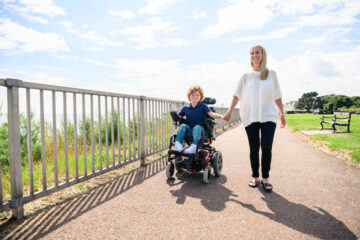Diagnosing cerebral palsy in children poses a couple of unique challenges. This is due to a variety of factors, not the least of which is that it can take many different forms. Not only can it vary dramatically in terms of severity, but it can also impact completely different parts of the body and manifest in diverse ways. As the most aggressive, daring, and successful birth injury lawyers in Maryland, one of our goals is to clarify the many forms that CP can take. For this reason, we have laid out three of the most common types of cerebral palsy.

Cerebral palsy can take many different forms. Here are a few of the most common types.
Spastic
By far the most common among the types of cerebral palsy, spastic CP is associated with jerky movements. You may also hear this form of CP referred to as ‘pyramidal.’ This is because spastic cerebral palsy occurs as a result of damage to pyramidal tracts, which govern signals from the brain to muscles.
Here are a few other symptoms of this form of the disorder:
- Unusual gait, such as a tendency to walk on tiptoes
- Exaggerated motions
- Poor reflexes
- Inability of joints to fully extend
Spastic cerebral palsy can occur in the arms, legs, or both. It may also only impact one side of the body.
Athetoid
The second most commonly occurring form of the disorder, athetoid cerebral palsy is sometimes referred to as ‘extrapyramidal.’ In contrast to our first example, the portion of the brain impacted here controls involuntary reflexes.
Individuals with athetoid CP will exhibit involuntary movement. This can occur almost anywhere in the body, but is most common in the face and limbs.
Ataxic
Ataxic cerebral palsy can occur as a result of damage to the cerebellum. Like other forms of the disorder, this damage can be caused before, during, or not long after birth. If it happened during the birthing process, it was most likely caused by birth asphyxia, and may have been the result of medical negligence.
The cerebellum is crucial to all kinds of motor function, but it is especially important as the portion of the brain that controls balance and coordination. Unlike those with athetoid cerebral palsy, individuals with ataxic CP may have difficulty with voluntary movement.
Here are a few symptoms you should be aware of:
- Poor depth perception
- Shakiness
- Difficulties with fine motor movements such as writing or grasping small objects
If your child has one of these forms of cerebral palsy, there is a chance that it was caused by medical malpractice. A lawsuit can help to cover the costs of the therapy your child needs. Do not hesitate to reach out to the experienced birth injury lawyers at Snyder Law Group.
Contact The Snyder Law Group Today
The Snyder Law Group, LLC, proudly represents clients throughout Maryland and Washington, D.C. Our experienced Baltimore attorneys understand the frustration that comes with an insurance company, medical professional, or other party that refuses to accept liability for negligent or reckless behavior. You can take heart in knowing there are talented and experienced lawyers ready to work for you. We are experienced in handling personal injury claims of medical malpractice or injury resulting from serious car and truck accidents, and have secured hundreds of millions in verdicts settlements*. Please visit our website, www.410thefirm.com, for more information and follow us on Facebook, Twitter, and LinkedIn.
